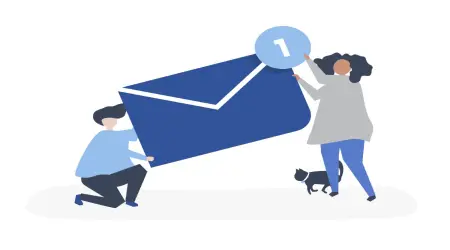

Email Marketing for Consultants: Attracting and Keeping Clients
Introduction
Email marketing is one of the best tools consultants can use to get new clients and keep the ones they already have. By sending out helpful and interesting emails, consultants can build trust and make lasting relationships. With the right plan, email marketing can totally change the game for anyone in consulting.
In this article, we’ll go over smart email strategies and tips just for consultants. Whether you're trying to find new clients or keep the ones you already have happy, email marketing can help you to achieve your business goals.
Why Email Marketing is Super Important for Consultants

The Power of Direct Communication
Email lets consultants talk directly to their clients and potential clients. Unlike social media or ads, emails feel more personal and can be customized to each person. This helps make sure your messages are reaching the right people.
- Personalized Messaging: You can adjust your emails based on what each client likes or needs, so they’re more likely to pay attention.
- Building Relationships: Sending regular emails keeps you on your clients' minds and helps them trust you more.
- Actionable Insights: Email tools let you see how people interact with your emails, so you can understand what works best.
With email, you’re not just sending messages, you’re connecting with people in a way that feels personal and meaningful.
Building Trust and Credibility
Sending emails regularly helps you build trust with both new and existing clients. By sharing helpful things like tips, case studies, or news from your industry, you show that you really know your stuff.
- Long-Term Engagement: Sending good emails over time helps you build a strong connection. Clients will feel more confident that you know what you’re doing.
- Demonstrating Expertise: When you share useful information, it shows clients that you understand their problems and know how to fix them.
As trust grows, so does the chance that potential clients will turn into loyal ones. Email marketing helps you keep these relationships going strong.
Higher ROI Compared to Other Channels
Email marketing gives you one of the highest returns on investment (ROI) compared to other ways of marketing. Studies show that businesses can make $42 for every $1 spent on email marketing. That’s way more than what you’d get from social media ads or pay-per-click campaigns.
- Cost-Effective: Email is one of the cheapest ways to market your business, and it works really well.
- Targeted Reach: By organizing your email list, you make sure your emails go to the people who need them most. This helps you avoid wasting time and effort.
With the ability to track your emails and make changes to improve them, email marketing is a smart and cost-effective tool for any consultant who wants to grow their business.
Crafting an Effective Email Marketing Strategy for Consultants
Defining Your Target Audience
Before you start sending emails, you need to know exactly who you’re trying to reach. Understanding your audience helps you create emails that speak to their needs and interests.
- Identify Industries: Think about which industries benefit the most from your consulting services. Whether it’s healthcare, tech, or finance, knowing who you’re targeting makes your emails more powerful.
- Understand Pain Points: Find out what problems your potential clients are facing. When you tailor your emails to solve these issues, they’ll connect with your audience much more.
- Segment Your Email List: Organize your email list into groups based on industry, past interactions, or client type. This way, each group gets emails that are the most useful to them.
The more you understand your target audience, the better your emails will be. When you know what they need, you can create messages that not only grab their attention but also get them to take action.
Creating a Compelling Lead Magnet
A lead magnet is something valuable you offer in exchange for someone’s email address. It’s a great way to grow your email list with people who are interested in your services.
Here are a few lead magnet ideas:
- Ebooks: Offer a free guide or eBook that’s related to your consulting services.
- Webinars: Host a free webinar where you share cool tips or insights from your industry.
- Checklists or Templates: Give away helpful tools like checklists or templates that your audience can use.
These lead magnets help you collect contact details while giving your audience something valuable. By following through on your promises, you build trust and set yourself up for future business.
Structuring Your Email Campaigns
Once you’ve got your targeted list and lead magnet, it’s time to set up an email campaign. A good campaign ensures that your emails are both fun to read and helpful.
- Welcome Emails: Start by thanking people for subscribing to your list and let them know what kind of emails they can expect.
- Educational Content: Send helpful information, like blog posts or industry news, that shows you’re an expert in your field.
- Promotional Offers: Sometimes, send emails about your consulting services or any special deals.
- Newsletters: Keep your clients updated with regular emails full of news and extra resources.
The trick is balance: don’t just send promotional emails all the time. Mix in useful, educational content to keep your audience from feeling like they’re always being "sold to."
Best Practices for Writing Engaging Emails

Crafting Attention-Grabbing Subject Lines
Your subject line is the first thing people see, and it can make or break whether they open your email. A good subject line will get them curious and interested.
- Personalization: Add the recipient’s name or company name to make the email feel special. For example, “John, Here’s a Tip for Improving Your Business.”
- Curiosity: Get them curious, but don’t be too mysterious. A subject like “The Secret to Boosting Your Consulting Sales” will make them want to know more.
- Keep It Short: Try to keep subject lines under 50 characters so they’re easy to read on mobile.
Your subject line should make the reader want to open the email. It should match the email content and promise something valuable.
Writing Clear, Concise, and Value-Driven Content
Once the recipient opens your email, you want the content to be easy to understand and valuable. The body of your email should focus on giving clear, useful information.
- Clarity Over Complexity: Use simple language and short paragraphs to keep things easy to read.
- Strong Call-to-Action (CTA): Your CTA should stand out and clearly tell the reader what to do next. For example, “Schedule Your Free Consultation” or “Download Your Free Guide.”
- Create Urgency: Encourage action with phrases like “Offer ends in 48 hours” or “Limited spots available.” This gets people to act quickly.
The goal is to give value in every email. If your emails provide useful tips and easy steps, people will look forward to reading your future emails.
Personalizing Emails to Increase Engagement
Personalizing emails goes beyond just adding the recipient’s name. Tailoring your emails to their interests or past behavior can really boost engagement.
- Dynamic Content: Use content that changes depending on what the recipient has done before. For example, if someone downloaded a specific eBook, you can offer them related content in future emails.
- Segmented Offers: Customize your offers based on where the recipient is in their journey. Give special discounts to new leads or more detailed options to people ready to buy.
The more you personalize your emails, the more likely people will engage. Personalization makes people feel special and helps create stronger relationships.
Automating Your Email Marketing Efforts

Email Marketing Automation Tools for Consultants
Automating your email campaigns can save you a lot of time and ensure you're staying in touch with your clients and prospects regularly. By using the right tools, consultants can set up automated systems to nurture leads, onboard new clients, and send follow-up emails at just the right time.
Here are some popular email marketing tools:
- Mailchimp: This tool is super easy to use with drag-and-drop email builders. It's perfect for consultants who are just getting started with email marketing.
- ConvertKit: Tailored for creators and consultants, ConvertKit offers advanced features like segmentation and automated workflows to personalize emails and nurture leads.
- ActiveCampaign: This is great for consultants who need more advanced automation, like trigger-based emails and detailed performance tracking.
These tools allow you to schedule email sequences, segment your email list, and send targeted messages based on actions your recipients take. This ensures your email marketing runs smoothly without having to do everything manually.
Setting Up Automated Workflows
Now that you have your automation tool, it’s time to create workflows that will make your email marketing more efficient and effective. Automation means you can send the right email at the perfect time without having to write and send them all manually.
- Client Onboarding: Set up a welcome series to automatically introduce new clients to your services and provide helpful resources.
- Re-engagement: Create workflows to follow up with clients who haven’t interacted with your emails in a while, offering new content or special deals.
- Post-Consultation Follow-up: Send an automated thank-you email after a consultation, along with a feedback survey or recommendations for further services.
Automation frees up your time and ensures that your clients get timely, relevant content, making their experience with you even better.
Measuring and Analyzing Email Marketing Success
Key Email Marketing Metrics to Track
To make sure your email marketing is working, you need to keep an eye on important metrics that show how well your emails are performing. Here are the key things to track:
- Open Rate: This shows you how many people opened your email. A higher open rate means your subject line and sender name are grabbing attention.
- Click-Through Rate (CTR): This tells you how many people clicked on links in your email. A high CTR means your email content is interesting and engaging.
- Conversion Rate: This measures how many people took the action you wanted them to take, like scheduling a consultation or downloading a free guide. This shows how well your emails are turning leads into clients.
- Unsubscribe Rate: If people are unsubscribing, that’s a sign to rethink your content or how often you're sending emails. Keep this rate low by offering value and respecting your subscribers' inboxes.
By tracking these metrics, you can keep improving your email campaigns to increase engagement and conversions.
A/B Testing for Continuous Improvement
A/B testing is a powerful way to improve your email campaigns. It lets you test two different versions of an email to see which one works better.
Here’s what you can test:
- Subject Lines: Try testing different approaches like using a person’s name versus a general greeting or testing a sense of urgency.
- Calls-to-Action (CTAs): Experiment with different CTAs to see which one motivates people to take action. For example, “Get Started” vs. “Learn More.”
- Design and Layout: Test different email designs, like using more images or a text-heavy format.
How to A/B Test:
- Create Two Versions: Make two versions of your email, changing one element at a time (like the subject line).
- Split Your List: Divide your list into two groups randomly.
- Track Results: See which version gets a higher open rate, CTR, and conversion rate.
- Optimize: Use the winning version for future emails and keep testing other elements.
A/B testing helps you make small tweaks that can lead to big improvements in your email marketing.
Retaining Clients Through Email Marketing
Providing Ongoing Value with Regular Email Communication
Keeping clients is just as important as attracting new ones. Regular emails remind your clients of the value you bring, helping them stay engaged with your services.
- Newsletters: Share useful insights, industry news, or success stories to position yourself as an expert and keep your clients informed.
- Case Studies and Testimonials: Show the results of your work through detailed case studies or testimonials. This builds trust and shows how you’ve helped others.
- Exclusive Content: Offer tips, advice, or tools specifically designed to help your clients improve their business. When clients see real value in your emails, they’re more likely to stay connected.
By keeping regular communication, you create an ongoing relationship with your clients, making them more likely to stay with you for the long term.
Exclusive Offers and Client-Only Content
Another great way to keep clients engaged is by offering them special deals and content. This makes them feel valued and increases their loyalty.
- VIP Access: Give clients access to exclusive webinars, special sessions, or members-only resources. This could be a private group or advanced insights only available to your loyal clients.
- Discounts and Special Offers: Send out exclusive discounts for services or special packages. For example, offer a returning client a discount on a new service or a free consultation for loyal clients.
- Early Access to New Services: Let your clients be the first to know about new services or offerings, giving them a special edge.
Offering these exclusive perks makes clients feel like they’re getting more than just regular service, boosting loyalty and retention.
Requesting Feedback and Testimonials
Client feedback is incredibly valuable for improving your services and understanding what they really need. By requesting feedback through email, you keep the conversation going and gain insights into how your services are perceived.
- Survey Emails: Send short surveys to get opinions on how your clients feel about your services. For example, “How can we improve your experience with us?”
- Testimonial Requests: Ask happy clients to provide testimonials or reviews you can use in future campaigns. These help attract new clients by showing that others trust you.
- Using Feedback: Incorporate client feedback into your emails, showing how you’ve made improvements based on their suggestions.
This process shows clients you value their opinions and helps you improve your services and email content.
Conclusion: The Ongoing Journey of Client Attraction and Retention
To sum up, email marketing is a must-have for consultants who want to attract new clients and keep the ones they already have. By using the strategies and tips shared here, you can create an email marketing plan that helps you build long-lasting client relationships.
Continuous Refinement:
Email marketing is an ongoing journey. As your business grows, your email strategies should grow too. Always be open to trying new ideas, testing different approaches, and tweaking your campaigns to keep them fresh. Regularly check what’s working and what’s not, and adjust accordingly to stay ahead in the market.
Frequently Asked Questions
What’s the quickest way to grow a high-quality list?
Offer one tightly focused freebie that solves a real, costly problem, think a checklist, scorecard, or a short mini-workshop on a clean landing page. Promote it on LinkedIn and at your talks or webinars, and invite people to reply for a bonus or template. Quality beats volume for consultants; you just need the right buyers.
What should my welcome/nurture emails include to book calls?
Over about two weeks, send four to five short emails: start with a warm welcome that clarifies who you help and how, follow with a practical tip that fixes one pain point, share a brief before-and-after case study, address common objections, and end with a gentle invitation to book a consult. Keep the tone helpful and conversational, not pushy.
How often should I email?
Start weekly or every other week and stick to it. Watch replies, clicks, and unsubscribes, then adjust the cadence. Long gaps make people forget you; steady wins.
How can email help me keep clients and get repeat work?
Send a client-only monthly update with quick wins and recommendations, schedule a simple quarterly check-in to review results, and share mini-audits or next-step roadmaps when useful. Add a light referral nudge like “Know someone dealing with X? Reply ‘intro’,” so happy clients can easily refer you.
Which metrics should I track now that opens are unreliable?
Focus on outcomes and real engagement: replies, click-throughs, calls booked, conversions, plus list health signals like unsubscribes, spam complaints, and bounces. Treat open rate as a rough indicator, not your north star.
Is cold email legal, and how do I stay safe?
It depends on the recipient’s country. In the U.S., include your address, identify yourself clearly, provide an easy unsubscribe, and honor opt-outs promptly. In the UK/EU, you typically need consent for individuals, though some B2B outreach can rely on legitimate interest if you meet strict transparency and relevance tests. In Canada, you generally need consent (express or implied) and must include identification and a working unsubscribe in every message. Wherever you send, be transparent and remove opt-outs immediately.
Related Articles :-
- HVAC Email Marketing: Getting More Leads and Keeping Customers Happy
- Real Estate Email Templates: How to Craft the Perfect Email for Agents and Clients
- Email Marketing for Insurance: How to Build Trust and Help Clients Make Smart Choices
- How to Check Competitors' Email Marketing: Tools and Techniques for Competitive Analysis




